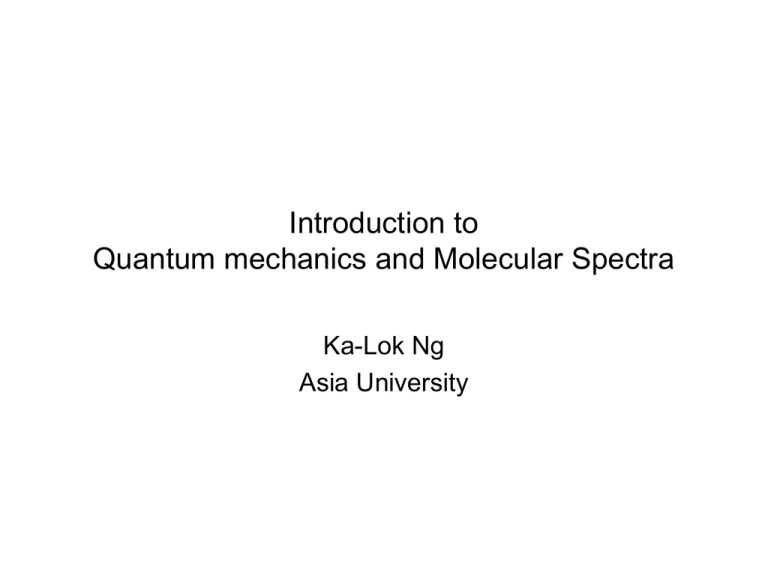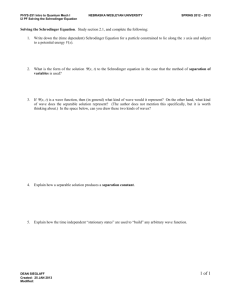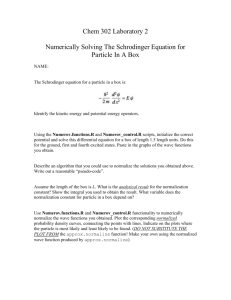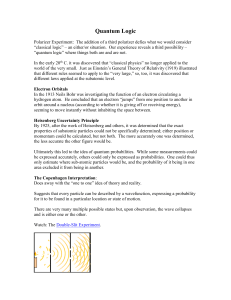Quantum mechanics – an introduction
advertisement

Introduction to Quantum mechanics and Molecular Spectra Ka-Lok Ng Asia University Contents • The postulates of quantum mechanics (QM) The wave equation – Schrodinger equation • Quantum mechanical operators • Eigenvalues of QM operators • Wave functions • The particle in a 1D box • Physical methods of determining the 3D structure of proteins References • House J.E. Fundamentals of quantum chemistry, 2nd ed. Elsevier 2004 • Whitford D. Proteins: structure and function. J. Wiley 2005. • http://www.spaceandmotion.com/Physics-Erwin-Schrodinger.htm • Molecular spectra, see http://spiff.rit.edu/classes/phys315/lectures/lect_14/lect_14.html http://cref.if.ufrgs.br/hiperfisica/hbase/molecule/molec.html#c2 The postulates of quantum mechanics (QM) Postulate I For any possible state of a system, there is a function y of the coordinates of the parts of the system and time that completely describes the system. ( x, y , z , t ) Is called a wave function. For two particles system, ( x1 , y1 , z1 , x2 , y2 , z2 , t ) The wave function square 2 is proportional to probability. Since may be complex, we are interested in *, where * is the complex conjugate (i -i) of . The quantity *dt is proportional to the probability of finding the particles of the system in the volume element, dt = dxdydz. * dt 1 all _ space that is the probability of finding the particle in the universe is 1 normalization condition. The postulates of quantum mechanics (QM) Orthogonal of two wave functions *ydt 0 y *dt 0 Example: sinq and cosq are orthogonal functions. sin q cosqdq 0 0 Fourier series expansion – sin(nq) and cos(nq) orthogonal functions The Wave Equation • • In 1924 de Brogile shown that a moving particle has a wave character. This idea was demonstrated in 1927 by Davisson and Germer when an electron beam was diffracted by a nickel crystal. According to the de Brogile relationship, there is a wavelength associate with a moving particle which is given by h mv where , h, m and v denote the wavelength, Planck’s constant, mass and velocity. Erwin Schrodinger adapted the wave model to the problem of the hydrogen atom and propose the Schrodinger equation. The model needs to describe a three-dimensional wave. Classical physics – the flooded planet problem = the waveforms that would result form a disturbance of a sphere that is covered with water The classical 3D wave equation is 2 2 2 1 2 2 2 2 2 2 x y z v t where is the amplitude function and v is the phase velocity of the wave. Schrodinger equation The Wave Equation The Schrodinger wave equation 2 2 2 4 2 m2 2( E V ) 2 2 2 2 x y z h m The 1D wave equation solution http://www-solar.mcs.stand.ac.uk/~alan/MT2003/PDE/node12.html The 2D wave equation solution http://www.math.harvard.edu/archive/21b_fall_03/waves/index.html Operators Postulate II With every physical observable q there is associated an operator Q, which when operating upon the wavefunction associated with a definite value of that observable will yield that value times the wavefunction F, i.e. QF = qF. H http://hyperphysics.phy-astr.gsu.edu/hbase/quantum/qmoper.html Operators (1) The operators are linear, which means that O(1 2) = O1 + O2 • The linear character of the operator is related to the superposition of states and waves reinforcing each other in the process (2) The second property of the operators is that they are Hermitian (the 19th century French mathematician Charles Hermite). • Hermitian matrix is defined as the transpose of the complex conjugate (*) of a matrix is equal to itself, i.e. (M*)T = M x iy a M x iy c x iy a M * x iy c x iy a M ( M * )T x iy c In QM, the operator O is Hermitian if * * * F O d t O F dt C. Hermite http://commons.wikimedia.org/wiki/Image:Charles_Hermite_circa_1887.jpg Eigenvalues of QM operator Postulate III • The permissible values that a dynamical variable may have are those given by OF = aF, where F is the eigenfunction of the QM operator (Hermitian) O that corresponds to the observable whose permissible real values are a. • The is postulate can be stated in the form of an equation as O operator F wave function = a eignevalue F wave function Example Let F = e2x and O=d/dx dF/dx = d(e2x)/dx = 2 e2x F is an eigenfunction of the operator d/dx with an eigenvalue of 2. Eigenvalues of QM operator • Eigenvalues of QM operator must be real ! • Example b ic a M d b ic solve Mx x (a )( d ) (b ic )(b ic ) 0 2 (a d ) ad b 2 c 2 0 The two values for are real Wave functions Postulate IV • The state function is given as a solution of Ĥ E • Schrodinger equation where Ĥ is the total energy operator, that is the Hamiltonian operator. The hamiltonian function is the total energy, T+V, where T is the kinetic energy and V is the potential energy. In operator form Hˆ Tˆ Vˆ where Tˆ is the operator for kinetic energy and Vˆ is the operator for potential energy. In differential operator form, the time dependent Schrodinger equation is h2 2 2 2 h ( V ( q , t )) ( q , t ) (qi , t ) i i 2 2 2 2 8m x y z 2i t where qi is the generalized coordinates, m is the mass of the particle. The particle in a one-dimensional box • • • • • We treat the behavior of a particle that is confined to motion in a box The coordinate system for this problem is show at the right The Hamiltonian operator, H, is H = T + V = p2/2m + V where p is the momentum, mass is the mass of the particle, and V is the potential energy Outside the box V = ∞, so the Schrodinger equation Hˆ E h2 d 2 E 8m 2 dx 2 For the equation to be valid, y must be 0 Boundary condition = the probability of finding the particle outside the box is zero Inside the box, V = 0, so the Schrodinger equation becomes h2 d 2 E 2 2 8m dx http://www.everyscience.com/Chemistry/Physical/Quantum_Mechanics/a.1128.php The particle in a one-dimensional box d 2 2 k 0 2 dx Where k2 = 82mE/h2. This is a linear differential equation with constant coefficients, which have a solution fo the form = A cos(kx) + B sin(kx). The constant A and B must be evaluated using the boundary conditions. Boundary conditions are those requirments that must be met becase of the the physical limits fo the system. For the probability of finding the particle to vanish at the walls of the box, that is = 0 both at x≦0 and x≧L. At x≦0 = 0 = A + B(0) A = 0 At x≧L = 0 = B sin kL Since B ≠ 0, otherwise the complete wavefunction = 0 ! sin kL = 0 that is kL = n quantization condition ! The particle in a one-dimensional box • • • quantization condition kL = n Recall k2 = 82mE/h2 k2 L2 = 82mE/h2 L2 = n22, where n = 1, 2 ……. is the quantum number n2h2 E 8mL2 • Zero-point energy • One quantum number arise from a 1D system E ~ n2 E ~ 1/L2 E~m To determine the wavefunction , one uses the normalization condition L dt B * all _ space ( x) 2 sin (n / L) xdx 1 2 n = 1, 2, 3 0 2 nx sin( ) L L http://www.everyscience.com/Chemistry/Physical/Quantum_Mechanics/a.1128.php The particle in a one-dimensional box • Consider a carbon chain like C=C-C=C-C • as an arrangement where the electrons can move along the chain. If we take an average bond length of 1.40 Angstrom, the entire chain would be 5.60 Angstrom length, Therefore, the energy difference between the n=1 and n=2 state would be 3h 2 3(6.63 10 27 erg s) 2 E 2 8mL 8(9.10 10 28 g )(5.60 10 8 cm) 2 E 5.78 10 12 erg The energy corresponds to a wavelength of 344 nm, and the maximum in the absorption spectrum of 1,3-pentadiene is found at 224 nm. Although this not close agreement, the simple model does predict absorption in the UV region of the spectrum. Molecular Spectra Three types of energy levels in molecules • electronic: large energy separations (200-400 kJ/mol) optical or UV • vibrational: medium energy separations (10-40 kJ/mol) Infrared • rotational: small energy separations (10-40 J/mol) microwave • All the energy levels are quantized Molecular Spectra • For a spectral line of 6000 Angstrom, which is in the visible light region, the corresponding energy is E = hc/ = 3.3x10-12 erg a molar quantity multiply by Avogadro’s number E = 200 kJ/mol • Diatmoic molecule can be viewed as if they are held together by bonds that have some stretching and bending (vibrational) capability, and the whole molecule can rotate as a unit. http://cref.if.ufrgs.br/hiperfisica/hbase/molecule/molec.html#c2 Molecular Spectra • Normal mode of vibration for the CO2 molecule behaves much like a simple harmonic oscillator • The vibrational energies can therefore be described by the relation (+1/2)*h, where , the vibrational quantum number = 0,1,2,3…. and =the classical frequency • the symmetric stretch mode • the asymmetric stretch mode • the bending mode http://www.phy.davidson.edu/StuHome/shmeidt/JuniorLab/CO2Laser/Theory.htm Vibrational and Rotational energy levels transition spectra • The CO2 molecule is free to rotate. The energies of the rotational modes (E = h2/(82I), where I is the moment of inertia)) are smaller than for vibrational modes. Hence, the energy levels for two vibrational states with the rotational divisions looks like: Vibrational and Rotational energy levels transition spectra for HCl http://universe-review.ca/F12-molecule.htm Applications of the Vibrational Energy Levels • • • • determination of bond lengths determination of bond force constants determination of bond dissociation energy qualitative and quantitative chemical analysis Selection rules for energy level transitions • Selection rules are divided into high probability or allowed transitions and Forbidden transitions of much lower probability • Forbidden transition – symmetry-forbidden and spin-forbidden transitions • Spin-forbidden transitions involve a change in spin multiplicity defined as 2S+1 where S is the electron spin number. Spin multiplicity reflects electron pairing (see Table). For a favourable transition there is no change in multiplicity (DS=0) Number of unpair Electron electrons spin S 2S+1 Multiplicity 0 0 1 Singlet 1 ½ 2 Doublet 2 1 3 Triplet 3 3/2 4 quartet Selection rules for energy level transitions • Symmetry-forbidden transitions reflect redistributin of charge during transitions in a quantity called the transition dipole moment. • Differences in dipole moment arise from the different electron distributions of ground and excited states • For an allowing transition it requires a change in dipole moment • EM radiation can induce Rotational transitions only in molecule with a permanent dipole moment. • Not all molecules have dipole moments! – (1) only polar molecules can absorb and emit electromagnetic photons – (2) non-polar molecules : H2 ,CO2 ,CH4 – (3) energy transfer can take place during collisions • The intensity of the signals in a rotational spectrum increase with the molecular dipole moment. Fluorescence Spectroscopy • • • • • • • Fluorescence – excited molecules decay to the ground state via the emission of a photon with DS = 0 ( no change in spin multiplicity, S1 S0) Emission is occurs at longer wavelengths than the corresponding absorbance band Quantum yield of Fluorescence emission = photons emitted/number of photons absorbed maximum value of quantum yield is 1 Photophysical properties of a fluorophore can be used to obtain information on its immediate molecular environment. Relaxation of a fluorophore from its excited state can be accelerated by fluorescence resonance energy transfer (FRET). FRETcan be used to characterize proteinprotein interactions as observed in signaling complexes of ion channel proteins. http://www.physiologie.uni-freiburg.de/fluorscence.html Raman Spectroscopy • • • • Chandrasekhara Venkata Raman (1888-1970) who discovered in 1928 that light interacts with molecules vai absorbance, transmission or scattering the first Indian Nobel Laureate in physics Raman made many major scientific discoveries in acoustics, ultrasonic, optics, magnetism and crystal physics Scattering can occur at the same wavelength when it is known as Rayleigh scattering (elastic, 0) or it can occur at altered frequency (change in the colour of the scattered light) when it is the Raman effect Figure. See http://www.search.com/reference/Raman_spectroscopy Figure. See http://www.inphotonics.com/raman.htm http://www.vigyanprasar.gov.in/dream/feb2002/article1.htm Raman Spectroscopy • some weaker bands of shifted frequency are detected. Moreover, while most of the shifted bands are of lower frequency 0 - i, there are some at higher frequency, 0 + i. By analogy to fluorescence spectrometry, the former are called Stokes bands and the latter antiStokes bands. The Stokes and anti-Stokes bands are equally displaced about the Rayleigh band; however, the intensity of the anti-Stokes bands is much weaker than the Stokes bands and they are seldom observed. http://www.gfz-potsdam.de/pb4/pg2/equipment/raman/raman.html Raman Spectroscopy Application • commonly used in chemistry • provides a fingerprint by which the molecule can be identified. The fingerprint region of organic molecules is in the range 500-2000 cm-1. • to study changes in chemical bonding, e.g. when a substrate is added to an enzyme. • Raman gas analyzers have many practical applications, for instance they are used in medicine for real-time monitoring of anaesthetic (麻醉的) and respiratory gas mixtures during surgery. • In solid state physics, spontaneous Raman spectroscopy is used to, among other things, characterize materials, measure temperature, and find the crystallographic orientation of a sample. http://www.search.com/reference/Raman_spectroscopy Nuclear Magnetic Resonance Spectroscopy In 1945, the NMR phenomenon was given by F. Bloch and E. M. Purcell (both share the 1952 Nobel Prize) NMR spectra are observed upon the pulse absorption of a photon (radio frequency) of energy and the transition of nuclear spins from ground to excited states Bloch F (1905-1983) Purcell E.M. (1912-1997) http://nobelprize.org/nobel_prizes/physics/laureates/1952/ http://cancer.stanford.edu/research/milestones/ http://www.pulseblaster.com/gallery/1.html Nuclear Magnetic Resonance Spectroscopy For 1H there are two orientations. In one orientation the protons are aligned with the external magnetic field (north pole of the nucleus aligned with the south pole of the magnet and south pole of the nucleus with the north pole of the magnet) and in the other where the nuclei are aligned against the field (north with north, south with south) = aligned against = aligned with A spinning nucleus is equivalent to a magnet http://www.brynmawr.edu/Acads/Chem/mnerzsto/The_Basics_Nuclear_Magnetic_Resonance%20_Spectroscopy_2.htm http://vam.anest.ufl.edu/simulations/nuclearmagneticresonance.php Nuclear Magnetic Resonance Spectroscopy Nuclei possessing angular moment (also called spin) have an associated magnetic moment (current generate magnetic field). Certain atomic nuclei, such as 1H, 13C, 15N and 31P have spin S=½ and 2H, 14N have spin S=1, 18O has S=5/2). For nuclei such as 12C is the most common isotope is NMR silent, that is not magnetic. If a nucleus is not magnetic, it can't be studied by nuclear magnetic resonance spectroscopy. For the purposes, biomolecular NMR spectroscopy requires proteins enriched with 1H, 13C or 15N or ideally all nuclei. Nuclear transitions differed in frequency from one nucleus to another but also showed subtle differences according to the nature of the chemical group (chemical shift effect). Methyl protons resonating at a frequency ≠ amide proton ≠ a-carbon proton ≠ b-carbon proton The chemical environment of such nuclei are different Probe by NMR and this technique can be exploited to give information on the distances between atoms in a molecules. These distances can then be used to derive a 3D model of the molecule. f H 0 2 f frequency _ of _ absorption gyromagnetic _ ratio _ of _ the _ nucleus H 0 external _ magnetic _ field The frequency range needed to excite protons is relatively high. It ranges from 300 MHz to 900 MHz. Nuclear Magnetic Resonance Spectroscopy Why do we see peaks ? • When the excited nuclei in the beta orientation start to relax back down to the alpha orientation, a fluctuating magnetic field is created. This fluctuating field generates a current in a receiver coil that is around the sample. The current is electronically converted into a peak. Why do we see peaks at different positions? • because nuclei that are not in identical structural situations do not experience the external magnetic field to the same extent. The nuclei are shielded or deshielded due to small local fields generated by circulating s, and lone pair electrons. NMR spectra Solid-state 900 MHz (21.1 tesla) NMR spectrometer at the Canadian National Ultrahigh-field NMR Facility for Solids. http://www.answers.com/topic/solid-state-nuclear-magnetic-resonance http://www.scielo.br/scielo.php?pid=S0100-41582002000500017&script=sci_arttext Nuclear Magnetic Resonance Spectroscopy Limitations for NMR methods 1. For small proteins with size < 100 kD 2. Require highly concentrated protein solutions on the order of 1-2 mM. 3. pH of solution < 6.







